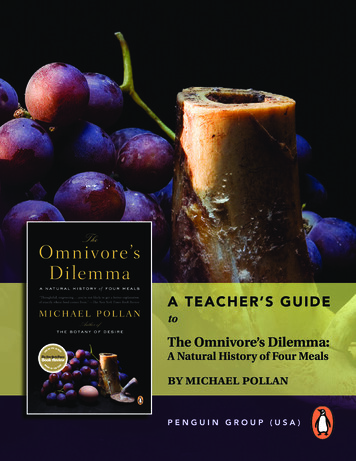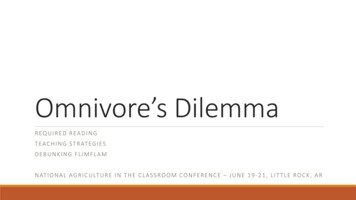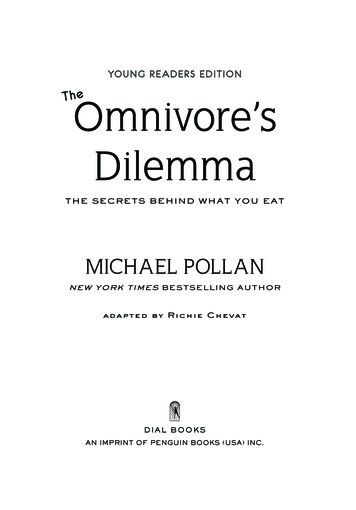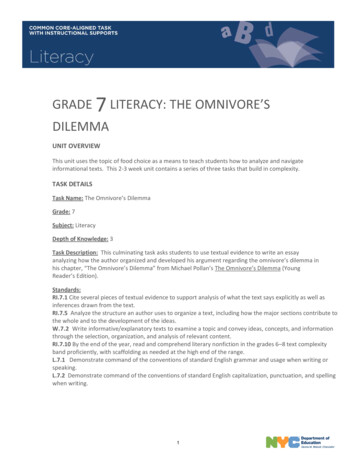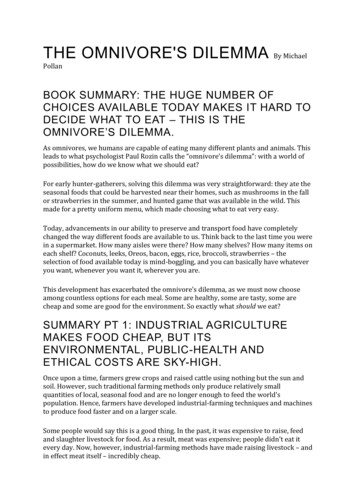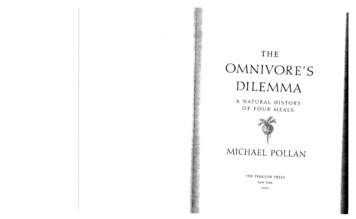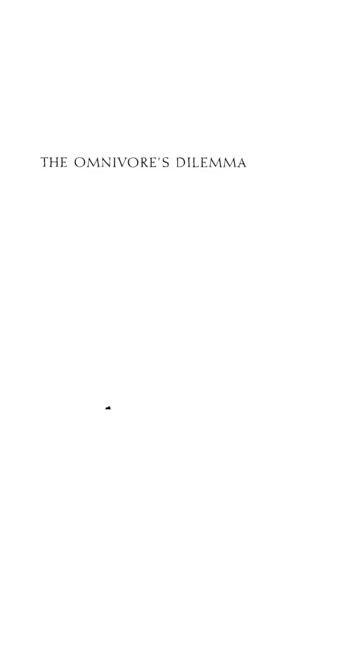
Transcription
THE OMNIVORE'S DILEMMA
ALSO BY MICHAEL POLLANSecond NatureA Place of My OwnThe Botany of Desire
THEOMNIVORE'SDILEMMAA NATURAL HISTORYOF FOUR MEALSMICHAEL POLLANTHE PENGUIN PRESSNew York2006
THE PENGUIN PRESSPublished by the Penguin GroupPenguin Group (USA)Inc.,375 HudsonStreet,Penguin Group (Canada), 90 Eglinton AvenueM4P 2Y3(a divisionof Pearson Penguin CanadaLondon WC2R 0RL, EnglandIreland (a division of Penguin Books Ltd)GroupPty Ltd)31Penguin Books India Pvt»017, IndiaAlbany, Auckland 1310,Inc.)Penguin Ireland, 25»Camberwell Road, Camberwell, VictoriaNew Delhi -110New York, New York 10014, U.S.A.Penguin Books**700, Toronto, Ontario, CanadaEast, SuiteSt.Ltd,80 Strand,Stephen's Green, Dublin 2,Penguin Books AustraliaLtd,25024, Australia (a division of Pearson AustraliaLtd,1 1CommunityCentre, Panchsheel Park,Penguin Group (NZ) Cnr Airborne and Rosedale Roads, ,NewZealand (a division of PearsonPenguin Books (South Africa)(Pty) Ltd,NewZealand Ltd) 24 Sturdee Avenue,Rosebank, Johannesburg 2196, South AfricaPenguin BooksLtd, Registered Offices:Firsta80 Strand, London WC2R 0RL, Englandpublished in 2006 by The Penguin Pressmember of Penguin Group (USA)Copyright Michael Pollan,Inc.2006All rights reservedLIBRARY OF CONGRESS CATALOGING IN PUBLICATION DATAPollan, Michael.The omnivore's dilemma:a natural historyof four meals / Michael Pollan.cm.p.Includes bibliographical references and index.ISBN 1-59420-082-31.GT2850.P65 .P65 2006394.T2—dc222005056557Printed in the United States of America1513171920181614DESIGNED BY MARYSARAH QUINNWithout limiting thepublicationrightsunder copyright reserved above, no part ofmay be reproduced,transmitted, in any form, or by anyrecordingorotherwise),thisstored in or introduced into a retrieval system, ormeans(electronic, mechanical, photocopying,without the prior written permission of both thecopyright owner and the above publisher of this book.The scanning, uploading, and distribution ofothermeans without the permission oflaw. Pleasethisbookthe publishervia the Internet or via anyisillegaland punishable bypurchase only authorized electronic editions and do not participate in orencourage electronic piracy of copyrightable materials. Your support of the author'srightsisappreciated.
FOR JUDITH AND ISAAC
CONTENTSintroduction Our National Eating Disorder1INDUSTRIALCORNIone ThePlant: Corn'stwo The FarmConquest 1532three The Elevator 57four The Feedlot: Making Meat 65The ProcessingfivesixPlant:Making Complex FoodsThe Consumer: A Republic of Fat 100sevenThe Meal:FastFood 109PASTORALII GRASSeight All FleshIsGrassnine Big Organic 13412385
ten Grass: Thirteen Ways of LookingelevenThe Animals:at aPasture185Practicing Complexity 208twelve Slaughter: In a Glass Abattoir 226thirteen The Market: "Greetings from the Non-Barcode People" 239fourteen The Meal: Grass-Fed 262PERSONALTHE FORESTfifteenThe Forager 277sixteenThe Omnivore'sDilemma 287seventeen The Ethics of Eating Animals 304eighteen Hunting: The Meat 334nineteenGathering The Fungi 364twenty The:PerfectMeal 391acknowledgments 413SOURCES 417index 437
THE OMNIVORE'S DILEMMA
INTRODUCTIONOUR NATIONALEATING DISORDERWhatshouldwehave for dinner?bookThisisa longandfairlysimple question. Along the way,itinvolved answer to this seeminglyalso tries to figure outhowsuchawewisdom we maysimple question could ever have gotten so complicated. As a cultureseemto have arrived at a placewhere whatevernativeonce have possessed about eating has been replaced by confusion andSomehowanxiety.to eatdid—has comewethis—most elemental of activitiesto require a remarkableever get to a pointwhere we needfiguring outamount of experthelp.whatHowinvestigative journalists to tellus where our food comes from and nutritionists to determine the din-nermenu?Formeof 2002,lifethe absurdity of the situationbecame inescapablewhen one of the most ancient and venerablestaplesin thefallof humanabruptly disappeared from the American dinner table. I'm talking ofcourse about bread. Virtually overnight, Americans changed thetheyeat.A collective spasm of what can only bewaydescribed as carbopho-
2 : THE OMNIVORE'S DILEMMAbia seized the country, supplanting an era of national lipophobia datingto the Carter administration. Thatteehad issuedAndset off the seasowechange?ItindutifullyThe newmany of them inspired byRobertuntilnow.appears to have been a perfect mediascientific studies,Dr.977, a Senate commit-had done,storm of diet books,diet books,1warning beef-loving Americansa set of "dietary goals"to lay off the red meat.Whatwas when,and one timely magazinethe formerly discreditedbrought Americans the welcome newsC. Atkins,could eat more meat and lose weightjust soarticle.longthat theyas they laid off thebread and pasta. These high-protein, low-carb diets found support in ahandful of new epidemiological studies suggesting that the nutritionalorthodoxywrong.Itthatwashad held sway in America since the 1970s might benot, as official opinion claimed, fat thatmadeusbutfat,the carbohydrates we'd been eating precisely in order to stay slim. Soconditions were ripe for a swing of the dietarysummer of 2002,thenewtheNew York Timesresearch entitled"Whatpendulum when,in theMagazine published a cover storyDoesn'tif FatMake YouFat?"onWithinmonths, supermarket shelves were restocked and restaurant menusrewritten to reflect thesteak restored,knowntonewnutritionalwisdom. The blamelessness oftwo of the most wholesome and uncontroversial foods—breadman—acquiredand pastaamoralthatstainpromptly bankrupted dozens of bakeries and noodle firms and ruinedan untold number of perfectly good meals.So violent a change in a culture's eating habitsissurely the sign ofwould never have happenedin aculture in possession of deeply rooted traditions surrounding foodanda national eating disorder. Certainlyeating.itBut then, such a culture would notgust legislativebodyfor that matter, todesign of anpolitical battle everywould not beitsmost au-government graphiccommonsense) of asusceptible to thefads, to the apotheosis every—or,few years over the precisecalled the "food pyramid."country with a stable culture of food would notthe quackery (orneed forto ever deliberate the nation's "dietary goals"wageofficialfeel thenewdietshellAout millions forbook everyJanuary.pendulum swings of foodItscares orfew years of one newly discovered nutri-
OUR NATIONAL EATING DISORDER*ent and the demonization of another.Itwould not beapt to confuseprotein bars and food supplements with meals or breakfast cereals withmedicines.Itfully a thirdprobably would not eat aof its childrenwould not benearly soNor would suchfifthof its meals in cars or feedevery day.at a fast-food outletAnditsurelyfat.a culturebe shocked to discover that there areother countries, such as Italy and France, that decide their dinner questionsandonthe basis of such quaint and unscientific criteria as pleasuremanner of "unhealthy"tradition, eat allwind upactually healthiershow ourand happier infoods, and, lo and behold,their eating thanweare.Wesurprise at this by speaking of something called the "Frenchparadox," forhowcould a peoplewhoeatsuch demonstrably toxicsubstances as foie gras and triple creme cheese actually be slimmer andhealthier thanweare? YetIwonderif itspeak in terms of an American paradoxpeople obsessed by the idea of eatingTo one degree orsailsthing nature has to offer, decidingthata notably unhealthyis,healthily.writers like RousseauisWhen youcan eat just about any-what you shouldwhen some of theto sicken or kill you. Thisyears ago—sense toanother, the question of what to have for dinner as-every omnivore, and always has.anxiety, especiallymake moredoesn'teat will inevitably stirpotential foodsonoffer are liablethe omnivore 's dilemma, noted long ago byand Brillat-Savarin andfirstgiven thatnamethirtyby a University of Pennsylvania research psychologist namedPaul Rozin. I'veborrowedthe omnivore 'sdilemma turns outhis phrase for the tidetoofthisbook becausebe a particularly sharp tool forunderstanding our present predicaments surrounding food.In a1976 papercalled"The Selection of Foods byand Other Animals" Rozin contrasted the omnivore 'stion with that of the specialized eater, forwhomRats,Humans,existential situa-the dinner questioncould not be simpler. The koala doesn't worry about what toIf itThelooks and smells and tastes like a eucalyptuskoala's culinary preferences areleaf, ithardwired initsmust beeat:dinner.genes. But for3
—4 *THE OMNIVORE'S DILEMMAomnivoresus (and thelikemust be devotedto figuring outnature lays on are safe torecognition andmushroomthatrat) a vastmemorymade meeat.amount of brain space and timewhich of allWerelyberries are the juicier, sweeter ones).Ourpotential disheson our prodigious powers ofaway from poisonsto guide ussick last week?)manythe(Isn't that theand toward nutritious plantstastebuds help(The redtoo, predisposing ustoward sweetness, which signals carbohydrate energy in nature, andaway from bitterness, which is how many of the toxic alkaloids producedby plantstaste.Our inbornsense of disgust keeps us from ingestingManythings that might infect us, such as rotten meat.webelieve that the reasonprecisely to help us dealBeing a generalistisiswhat allows humansevolved such big and intricate brains waswith the omnivore's dilemma.of coursea greatBut thesurfeitboonas well as a challenge;offers the pleasuresof choice brings witha lot of stressitofvariety,and leadskind of Manichaean view of food, a division of nature into TheThings toTheEat,ratto aGoodand The Bad.must makethis all-important distinctionown, each individual figuring outwhich thingsitto successfully inhabit virtually every terrestrialenvironment on the planet. Omnivorytoo.anthropologistswill nourishmore orlessonits—and then rememberingfor itselfand whichwill poison.The human omni-vore has, in addition to his senses and memory, the incalculableadvantage of a culture, which stores the experience and accumulatedwisdom of countless humanment withandtoit isthetastersmushroom nowIdon't need to experi-called, rather helpfully, the"death cap,"common knowledge that that first intrepid lobster eater was onsomething very good. Our culture codifies the rules of wise eating inan elaborate structure of taboos,traditions thatatbefore him.rituals, recipes,manners, and culinarykeep us from having to reenact the omnivore's dilemmaevery meal.One way to think about America's national eating disorder is as the return,with an almostatavisticvengeance, of the omnivore's dilemma. Thecornucopia of the American supermarket has thrown us back on a bewildering food landscape wherewe onceagain have to worry thatsome of
OUR NATIONAL EATING DISORDERthose tasty-looking morsels mightpoisonous mushroom, but(Perhaps not as quickly as akill us.just as surely.) Certainly the extraordinaryabundance of food in America complicates the whole problem of choice.At the same time,many of thetoolsaged the omnivore's dilemma havefailed.As arelativelynewpopulations, each withitswith which people—sharpness herelost theirnation drawn frommanydifferentman-or simplyimmigrantown culture of food, Americans have never hada single, strong, stable culinary tradition toThehistoricallyguideus.lack of a steadying culture of food leaves us especially vulnera-ble to the blandishments of the food scientistand the marketer,forwhom the omnivore's dilemma is not so much a dilemma as an opportunity. It isverymuch in thefood industry to exacerbateinterest of theour anxieties about what toeat,the better to then assuagenew products. Our bewilderment in the supermarket is noreturn of the omnivore'sindustry, roots that,growing in placesAndsomarket orthemweatIlikedilemma has deep rootsfound, reachallthein theway backthem withaccident; themodern foodto fields ofcornIowa.find ourselveswhere we do, confrontingin the super-the dinner table the dilemmas of omnivorousness,some ofancient and others never before imagined. The organic apple or theconventional? And if the organic, the local one or the imported? The wildfishor the farmed? The transfatsor the butter or the "not butter"? Shallbe a carnivore or a vegetarian? Andif a vegetarian, a lacto-vegetarianvegan? Like the hunter-gatherer picking a novelest floorpickupand consultinghis senseof phrasesWhatstuff,Myismemory to determine itsthe package in the supermarket and,our senses, scrutinize thelabel, scratchinglike "heart healthy,""no"natural grill flavor" orswer the questionsTBHQoff the for-edibility,weno longer so confident ofour heads over the meaningor xanthanOmnivore's Dilemmawe faceor atrans fats," "cage-free," or "range-fed."anyway, and where in the world didwager in writing ThemushroomIitgum? Whatisall thiscome from?wasthat the bestwayto an-about what to eat was to go back to the very* 5
—6 *THE OMNIVORE'S DILEMMAbeginning, to follow the food chains that sustain us,the earth to the platelookto—to a smallnumber of actualthe getting and eating of food atata transactionsay, asitsway fromtheallmeals.wantedImost fundamental, whichbetween species in nature,andeatersjugation of the verb tothisbookeat, inthe active and passive.")approach the dinner questionisWhat Ias a naturalistis("Theeaten.whole of nature," wrote the English author William Ralph Inge,to"is atry tocon-doinmight, using thelong lenses of ecology and anthropology, as well as the shorter, more intimate lens of personal experience.Mypremiseisthat like every other creaturepart in a food chain,minesand our place into a considerable extentour omnivorousness has donepossess theomnicompetentsuited to tearingthatearth,humanstakefood chain, or web, deter-what kind of creature weare.Thefactofmuch to shape our nature, both body (weteethand jaws of the omnivore, equally wellmeat and grinding seeds) andpowers of observation and memory,as well asmental stance toward the natural world, owefactonsoul.Our prodigiousour curious and experi-muchto the biologicalof omnivorousness. So do the various adaptations we've evolved todefeat the defenses of other creatures so thatcluding ourskills athunting and cooking withwe mighteatSomefire.philosophershave argued that the very open-endedness of human appetitesible forboth our savagery andcivility,what weYetneed ofeat,wemarkedlybutethical rules,how werespon-manners, andhumans) standsrituals.Weinare not onlyeat, too.are also differentso.issince a creature that could con-ceive of eating anything (including, notably, otherparticularthem, in-from most ofnature's other eatersFor one thing, we've acquired the ability to substantiallymodify the food chains we depend on, by means of such revolutionarytechnologies as cooking withfire,hunting withfood preservation. Cooking opened up wholetools, farming,new vistasandof edibility byrendering various plants and animals more digestible, and overcomingmany ofthe chemical defenses other species deploy against beingeaten. Agriculture allowed us to vastly multiply the populations of afewfavored food species, and therefore in turn our own. And, most recently,
OUR NATIONAL EATING DISORDERindustry has allowed us to reinvent thehuman foodfrom thechain,synthetic fertility of the soil to the microwaveable can of soup designedtointo a car'sfitcup holder. The implications of thisour health and the health of the natural world,welastrevolution, forarestillstrugglingto grasp.The Omnivore's Dilemma isabout the three principal food chains thatand the hunter-gatherer.sustain us today: the industrial, the organic,Different as they are,or less thesamethree food chains are systems for doingallthrough whatthing: linking us,of the earth and the energy of the sun.even a Twinkie doesthis—Iteat, tomight be hardconstitutes anworld. As ecology teaches, and thiswemorethe fertilityhow, butto seeengagement with the naturalbooktries toshow,it'scon-allnected, even the Twinkie.Ecology also teaches thatamongtitionstored in thetemform of complex carbon molecules. A food chainability to synthesizeisonthem fromWarII,sunlight.One ofa sys-uniquethe themes of thisof the food chain, dating to thehas actually changed the fundamental rules ofgame. Industrial agriculture has supplanted a complete reliance onthe sun for our calories with somethingchain that drawsmuchofitslightit isfinitehas been abers) but not,boonresult(Ofthe sun, but unlike sun-of this innovation has beenamount of food energytothe sun: a foodfossil fuels instead.came fromand irreplaceable.) Thea vast increase in thenew underenergy fromcourse, even that energy originallythisisto species that lack the plant'sthat the industrial revolutionclose of Worldthisby green plants andspecies for the solar energy capturedfor passing those caloriesbookcompe-earth can be viewed as aonall lifeavailable tohumanity (allowing usour species;our num-to multiplyan unalloyed one. We've discovered that an abundance offood does not render the omnivore's dilemma obsolete. To the contrary,abundance seems only to deepenand thingsEach oftoit,giving usallsorts of newproblemsworry about.thisbook's three parts follows one of the principalhumanfood chains from beginning to end: from a plant, or group of plants,photosynthesizing calories in the sun,allthewayto amealatthe din-7
8* THE OMN'IVORE'S DILEMMAner end of that food chain. Reversing the chronological order,with the industrial food chain, sinceand concerns us the most.monocultureonfocusesisIt isfar the biggestand longest. Sinceitsacallfield inIowa whereinMarin County,itgrew onitslong, strangemov-California.The book's second part follows what—corn,follows a bushel of com-diet. This sectionultimate destination in a fast-food meal, eaten in ahighwaythe industrialwethe keystone species of the industrial food chain,modity corn from theonthe one that today involvesisa single plant: Zea mays, the giant tropical grassand so in turn of the moderning carbyalsostartthe hallmark of the industrial food chain, this sectionwhich has becomejourney tothatII—callto distinguishitfromsome ofthe pastoral food chain. This section exploresthe alternatives to industrial food and farming that have sprungupinrecent years (variously called "organic," "local," "biological," and "be-yond organic"), food chainsin surprisingingIways turn out inmight appearfact totobe preindustrial butbe postindustrial.Isetout think-could follow one such food chain, from a radically innovativefarm in Virginialocalthatthatworked on one recent summerImeal prepared from animals raised onitsto an extremelypastures. ButIpromptlydiscovered that no single farm or meal could do justice to the complex,branching story of alternative agriculture right now, and thatalso totrialreckon with the food chaintwo verycame fromfarawayThedifferent "organic" meals:my local Whole Foodsas Argentina)culture of grassesThough weforestsatPolyfacethe natural his-one whose ingredientsFarmitsinasorigins to a single poly-Swoope, Virginia.Personal, follows a kind of neo-Paleolithicof Northern California to a mealfrom ingredientsIfood chain wasfishweeatpreparedstilleat ahandful ofand wild mushrooms)less practicalshed fresh light on the wayIhunted, gathered, and grewtwenty-first-century eatershunted and gathered food (notablyterest in thisupsupermarket (gathered there fromand the other tracinglast section, titled(almost) exclusivelymyself.,growingfood chain from thetooxymoronically, the "indus-I call,organic." So the book's pastoral section servestory ofneededInowthan philosophical:,Imyin-hopedby immersing myself in the
OUR NATIONAL EATING DISORDERway weorder toate then. Insome unfamiliarmakethismealdoing sotree fruit. Insome of the most elemental questionsIhowto learngame andthings, including huntingmushrooms and urbanhadIdotoforaging for wildwas forced—and dilemmas—to confrontfaced by thehuman omnivore: What are the moral and psychological implications ofHow does one distinguishbetween the delicious and the deadly when foraging in the woods? Howpreparing, and eating a wild animal?killing,do the alchemies of the kitchen transform the rawsome of theThe endgreat delights ofresultI,modernto think of as themy humbleand thought-intensive dinner,enjoyed in the company of fellow foragers, gaverare incameturned out so well (though initdid) but because this labor-itof nature intoculture?of this adventure was whatPerfect Meal, not becauseopinionhumanstuffsme the opportunity,soto eat in full consciousness of everything involvedlife,in feeding myself: For once,Iwasable to pay the full karmic price ofa meal.Yet as different as these three journeys (and four meals) turned outfew themes kept cropping up. Oneto be, aisthat there exists a funda-mental tension between the logic of nature and the logic of human industry, at least asourselvesisit ispresently organized.in feedingprodigious, but at various points our technologiesinto conflict with nature'smaximizeOur ingenuityisthings, aswhen weby planting crops or raising animals inefficiencycultures. Thisways of doingAgreatmany of theowevironmental problems created by our food systemto oversimplify nature's complexities, atvast—connected—biological systema patch of soil, aoneliterally—toour attemptsboth the growing and the—andhuman bodyto the healthproblems of health and nutritionof theother.Idon'tyoueat-find athe health ofMany ofwe face today trace back tohappen on the farm, and behind those things standpoliciesmono-health and en-ing ends of our food chain. At either end of any food chainmentseek tosomething nature never does, always and for goodreasons practicing diversity instead.iscomethethings thatspecificgovern-few of us know anything about.meanto suggest thathuman foodchains have only recently* 9
—JO* THE OMNIVORE'S DILEMMAcomeinto conflict with the logic of biology; early agriculture and, longhuman hunting proved enormouslybefore that,we mightdestructive. Indeed,never have needed agriculture had earlier generations ofhunters not eliminated the species they depended upon. Folly in thegetting of our foodisnothing new. And yet thenewwefolliesare per-Bypetrating in our industrial food chain today are of a different order.replacing solar energy with fossil fuel, by raising millions of food ani-mals in close confinement, by feeding those animals foods they neverevolved toeveneat,and by feeding ourselves foodswerealize,farmore novel than wewith our health and the health of theare taking risksnatural world that are unprecedented.Another theme, or premisereally, is thattheway weour most profound engagement with the natural world.eat representsDaily,oureat-ing turns nature into culture, transforming the body of the world intoour bodies and minds. Agriculture has done more to reshape the naturalworld than anythingcomposition ofitselsewe humansand fauna. Our eatingflorationship with dozens of other specieswith whichweplants, animals,weallwefates aredeeplyweeat—fromthemush-—in the forest to the yeasts that leaven our breadcompelling, andthatand fungicould never have prospered apart.But our relationships with the wild specieslessalso constitutes a rela-species have evolved expressly to gratify ourto prosper together asrooms we picklandscapes and thedance of domestication that has allowed usdesires, in the intricateand them—itshave coevolved to the point where ourMany of theseentwined.do, bothfarmorearenomysterious. Eating puts us in touch withshare with the other animals, andallthat sets us apart.Itde-fines us.Whathowisperhaps most troubling, and sad, about industrial eatingthoroughlyitobscuresgo from the chickenthisworld inaallthese relationships and connections. To(Gallus gallus) tothe ChickenMcNuggetchainis allisto leavejourney of forgetting that could hardly be more costlynot only in terms of the animal's pain but in our pleasure,getting, or notisknowingin thefirstplace,about, the principal reasonit isiswhat thetoo.But for-industrialso opaque, forifwefoodcould
OUR NATIONAL EATING DISORDERseewhattrialliesagriculture,"Eatingalsoon theiswe wouldTolike asurelyeatwith a—and whatconsciousness ofallthought in the world;things initthatlifeis attheend of anthisbookissaid. It isdetermines to aisstaketobecome ofmight soundcan afford quiteBy comparison, the pleasures of eatingateatof the worldburden, but in practice few things incontent eatingeat.Though much has beenhow and what weto say eating in ignorance, are fleeting.fectlyweWendell Berry famouslya political act, too.we makefullerchange the wayact," asto obscure this simple fact,satisfaction.isandact,great extent the useit.of the increasingly high walls of our indus-an agriculturalan ecologicaldonefar sideindustrially,Many peopleindustrialmuchaswhichtoday seem per-food chain, without aprobably not for them. There arethat will ruin their appetites.But in the endthis is abookabout the pleasures of eating, the kinds of pleasure that are only deep-ened by knowing.1I
CORN
ONETHE PLANTCorn's Conquest1.A NATURALIST IN THE SUPERMARKETAir-conditioned, odorless, illuminated by buzzing fluorescent tubes,the American supermarket doesn't present itself as having verydo with Nature. Andmade,it'strue)I'm noteither—whatisthis place ifnot a landscape (man-teeming with plants and animals?just talkingabout the produce section or the meat counter,the supermarket's flora and fauna. Ecologically speaking, theseare this landscape'sfieldyetmuch tomostlegible zones, the placeswhereitdoesn't take aguide to identify the resident species. Over there's your eggplant,onion, potato, and leek; here your apple, banana, and orange. Spritzedwith morning dew every few minutes, Produceisthe only corner of thesupermarket where we're apt to think "Ah, yes, the bounty of Nature!"Which probablyexplains(sometimes flowers, too)whyissuch a garden ofwhat usuallyfruitsand vegetablesgreets the shoppercomingthrough the automatic doors.Keeprolling,back to the mirrored rear wall behind which the butch-
]6*THE OMNIVORE'S DILEMMAand you encounter aers toil,identify—there'ssetof species onlychicken and turkey, lamb andharder toslightlycow andpig.ThoughMeat the creaturely character of the species on display does seemfading, as thecows and pigs increasingly come subdividedand bloodless geometricallessbeinto bone-some of thiscuts. In recent yearstoinsuper-nowmarket euphemism has seeped into Produce, where you'llfindformerly soil-encrusted potatoes cubed pristine white, and "baby" carrotsmachine-lathed into neatly tapered torpedoes. But in general herein floraand fauna you don't needscientist, toVentureknow whatfarther,muchless afoodspecies you're tossing into your cart.comethough, and youwhere the very notion ofketto be a naturalist,to regions of thesupermar-species seems increasingly obscure: thecanyons of breakfast cereals and condiments; the freezer cases stackedwith "home meal replacements" and bagged platonic peas; the broadexpanses of soft drinks and toweringcliffsof snacks; the unclassifiablePop-Tarts and Lunchables; the frankly synthetic coffee whiteners andthe Linnaeus-defying Twinkie. Plants? Animals?!Thoughalways seem that way, even the deathless Twinkieof.well, precisely whatIdon'tsort of formerly living creature,synthesize our foodsIfyou do onit?i.e.,afrom petroleum,isspecies.at leastWehaven't yetnotdirectly.apt to be ofdifferent plantsthis single acreof land!constructed outoffhand, but ultimatelyto regard the supermarketimpressionhow manyknowismight notititsbeguntothrough the eyes ofaastounding biodiver-and animals (and fungi)Whatsomeare rep-could hopeforest or prairieThere must be a hundred different species in the producesection alone, a handfulmoreappears only to be increasing:in themeat counter. AndWhen I wasa kid,this diversityyou never sawradic-chio in the produce section, or a half dozen different kinds of mush-rooms, or kiwis and passionthe last few years awholefruitand durians and mangoes. Indeed, incatalog of exotic speciesfrom thetropics hascolonized, and considerably enlivened, the produce department. Overin fauna,quailonagood day you'reapt to find—beyond beef—and even bison, while in Fish you can catch notjustostrichandsalmon and
THE PLANT: CORN'S CONQUESTandshrimp butcatfishmeasure ofa landscape's health,tilapia, too. Naturalistsand the modern supermarket's devo-and choice would seemtion to varietyregard biodiversity as ato reflect, perhaps even pro-mote, precisely that sort of ecological vigor.Except for theandsalthandful of synthetic food additives, everyaedible item in the supermarketgrowing ina particular plantstretch of sea)this potatoMoveis fairlywas growna link in aa specificsomewhere onchaintion, thatisfood chainpatch of soilSometimes,earth.producein Idaho, thatonion came from a farm in Texas.from aborn in South Dakota and fattened ingrownbe afairlylabel doesn'tin Iowa.sec-short and easy to follow: As the netted bag says,Thetomore seldom,as in theprehensible:grain(or,over to Meat, though, and the chain grows longer and lesssteerwiththat beginsOnce youmentionthat that rib-eye steakacomcameKansas feedlot onget into the processed foodsdetermined ecological detective to follow theyou haveintricateandincreasingly obscure lines of connection linking the Twinkie, or thenondairy creamer, to a plant growing in the earth someplace, butitcanbe done.So what exactly would an ecological detectiveican supermarket discover,cart all theway backyears ago, aftershouldIIwere heto the soil?set loose inan Amer-to trace the items in hisshoppingThe notion begantooccupyrealized that the straightforward questioneat?" couldno longer be answered withoutfirstdidn'tneedin theworld dida journalist toitcome from?" Notstartonof industrial food: Any food whose provenancescure thatitfew"WhatIeating?very long ago an eateranswer these questions. Theone so often does suggests a pretty goodaaddressingtwo other even more straightforward questions: "What amAnd wheremeaisfact thattodayworking definitionsocomplex or ob-requires expert help to ascertain.—When started trying to follow the industrial food chain the onetha
the omnivore's dilemma anaturalhistory offourmeals michaelpollan thepenguinpress newyork 2006
